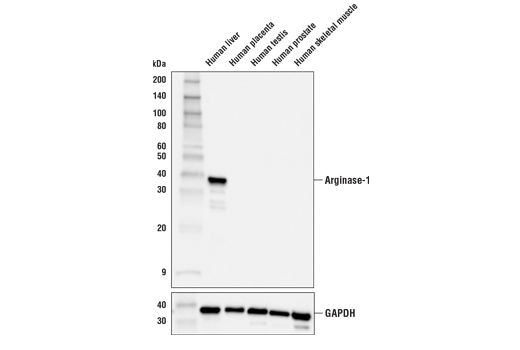
产品介绍
产品信息
抗原名称
Arginase-1

来源纯化
Monoclonal antibody is produced by immunizing animals with a synthetic peptide corresponding to residues surrounding Val47 of human arginase-1 protein.

宿主
Mouse

简单描述
Monoclonal Antibody for studying Arginase1. Cited in 3 publications. Validated for WB, IHC, IHC. Highly specific and rigorously validated in-house, Arginase-1 (E4U1I) Mouse Monoclonal Antibody (CST #43933) is ready to ship.

商品描述
Product Usage Information
| Application | Dilution |
|---|---|
| Western Blotting | 1:1000 |
| IHC Leica Bond | 1:800 - 1:3200 |
| Immunohistochemistry (Paraffin) | 1:400 - 1:1600 |

分子量
40

研究领域
癌症,代谢,神经科学

应用
反应种属
Human

目标/特异性
Specificity/Sensitivity
Arginase-1 (E4U1I) Mouse mAb recognizes endogenous levels of total arginase-1 protein. This antibody does not cross-react with arginase-2 protein.
Species Reactivity:
Human

敏感性
Endogenous

背景
背景
L-arginine plays a critical role in regulating the immune system (1-3). In inflammation, cancer, and certain other pathological conditions, myeloid cell differentiation is inhibited leading to a heterogeneous population of immature myeloid cells, known as myeloid-derived suppressor cells (MDSCs). MDSCs are recruited to sites of cancer-associated inflammation and express high levels of arginase-1 (4). Arginase-1 catalyzes the final step of the urea cycle converting L-arginine to L-ornithine and urea (5). Thus, MDSCs increase the catabolism of L-arginine resulting in L-arginine depletion in the inflammatory microenvironment of cancer (4,6). The reduced availability of L-arginine suppresses T cell proliferation and function and thus contributes to tumor progression (4,6). Arginase-1 is of great interest to researchers looking for a therapeutic target to inhibit the function of MDSCs in the context of cancer immunotherapy (7). In addition, research studies have demonstrated that arginase-1 distinguishes primary hepatocellular carcinoma (HCC) from metastatic tumors in the liver, indicating its value as a potential biomarker in the diagnosis of HCC (8,9).
1.Albina, J.E. et al. (1989) J Exp Med 169, 1021-9.
2.Mills, C.D. (2001) Crit Rev Immunol 21, 399-425.
3.Rodriguez, P.C. et al. (2004) Cancer Res 64, 5839-49.
4.Gabrilovich, D.I. and Nagaraj, S. (2009) Nat Rev Immunol 9, 162-74.
5.Wu, G. and Morris, S.M. (1998) Biochem J 336 (Pt 1), 1-17.
6.Raber, P. et al. (2012) Immunol Invest 41, 614-34.
7.Wesolowski, R. et al. (2013) J Immunother Cancer 1, 10.
8.Sang, W. et al. (2015) Tumour Biol 36, 3881-6.
9.Geramizadeh, B. and Seirfar, N. (2015) Hepat Mon 15, e30336.

研究领域
癌症,代谢,神经科学
翻译后修饰
Unmodified

制备和贮存
保存方式
Supplied in 10 mM sodium HEPES (pH 7.5), 150 mM NaCl, 100 µg/ml BSA, 50% glycerol and less than 0.02% sodium azide. Store at –20°C. Do not aliquot the antibody.For a carrier free (BSA and azide free) version of this product see product #41332.
数据库链接
Entrez-Gene ID
383

UniProt ID
P05089

声明 :本官网所有报价均为常温或者蓝冰运输价格,如有产品需要干冰运输,需另外加收干冰运输费。








 用小程序,查商品更便捷
用小程序,查商品更便捷







 危险品化学品经营许可证(不带存储) 许可证编号:沪(杨)应急管危经许[2022]202944(QY)
危险品化学品经营许可证(不带存储) 许可证编号:沪(杨)应急管危经许[2022]202944(QY)  营业执照(三证合一)
营业执照(三证合一)